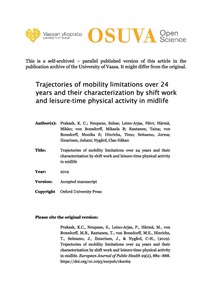Trajectories of mobility limitations over 24 years and their characterization by shift work and leisure-time physical activity in midlife
Prakash, K. C.; Neupane, Subas; Leino-Arjas, Päivi; Härmä, Mikko; von Bonsdorff, Mikaela B; Rantanen, Taina; von Bonsdorff, Monika E; Hinrichs, Timo; Seitsamo, Jorma; Ilmarinen, Juhani; Nygård, Clas-Håkan (2019-04-22)
Prakash, K. C.
Neupane, Subas
Leino-Arjas, Päivi
Härmä, Mikko
von Bonsdorff, Mikaela B
Rantanen, Taina
von Bonsdorff, Monika E
Hinrichs, Timo
Seitsamo, Jorma
Ilmarinen, Juhani
Nygård, Clas-Håkan
Oxford University Press
22.04.2019
Julkaisun pysyvä osoite on
https://urn.fi/URN:NBN:fi-fe2019102534873
https://urn.fi/URN:NBN:fi-fe2019102534873
Kuvaus
vertaisarvioitu
Tiivistelmä
Background: We aimed to investigate trajectories of mobility limitations (MLs) over a period of
24 years. In addition, we aimed to study how shift work and leisure-time physical activity (LTPA)
in midlife predict assignment to MLs trajectories separately for those retired on statutory pensions (SP) and on disability pensions (DP).
Methods: Subjects who responded MLs questionnaires (1985-2009, N=3048) in Finnish
Longitudinal Study on Aging Municipal Employees (FLAME) were included in this prospective
cohort study. LTPA and shift work was measured during baseline. International Classification of
Functioning was used to code MLs. Growth mixture modeling was used to identify the trajectories of MLs. Odds ratio (OR) and their 95% Confidence Interval (CI) were assessed by using multinomial logistic regression.
Results: We identified four trajectories of MLs, namely low persistent, low increasing, high
decreasing and high persistent. Among the SP recipients, shift work with night shifts was associated with an increased risk (adjusted OR 1.49; 95% CI 1.03–2.14) of belonging to the high persistent MLs trajectory. The inactive LTPA (SP: OR 5.99, 95% CI 3.39-10.58, DP: OR 6.81, 95% CI 2.52-18.43) was similarly associated with high persistent MLs trajectory.
Conclusions: Nearly two-thirds of the people retired due to disability belonged to high MLs
trajectory. High persistent MLs trajectory was associated with physical inactivity in midlife among those retired on SP and on DP. Shift work with night shift predicted high persistent MLs in SP strata. Active involvement in LTPA during midlife could be beneficial to spend MLs free later life.
24 years. In addition, we aimed to study how shift work and leisure-time physical activity (LTPA)
in midlife predict assignment to MLs trajectories separately for those retired on statutory pensions (SP) and on disability pensions (DP).
Methods: Subjects who responded MLs questionnaires (1985-2009, N=3048) in Finnish
Longitudinal Study on Aging Municipal Employees (FLAME) were included in this prospective
cohort study. LTPA and shift work was measured during baseline. International Classification of
Functioning was used to code MLs. Growth mixture modeling was used to identify the trajectories of MLs. Odds ratio (OR) and their 95% Confidence Interval (CI) were assessed by using multinomial logistic regression.
Results: We identified four trajectories of MLs, namely low persistent, low increasing, high
decreasing and high persistent. Among the SP recipients, shift work with night shifts was associated with an increased risk (adjusted OR 1.49; 95% CI 1.03–2.14) of belonging to the high persistent MLs trajectory. The inactive LTPA (SP: OR 5.99, 95% CI 3.39-10.58, DP: OR 6.81, 95% CI 2.52-18.43) was similarly associated with high persistent MLs trajectory.
Conclusions: Nearly two-thirds of the people retired due to disability belonged to high MLs
trajectory. High persistent MLs trajectory was associated with physical inactivity in midlife among those retired on SP and on DP. Shift work with night shift predicted high persistent MLs in SP strata. Active involvement in LTPA during midlife could be beneficial to spend MLs free later life.
Kokoelmat
- Artikkelit [2617]
